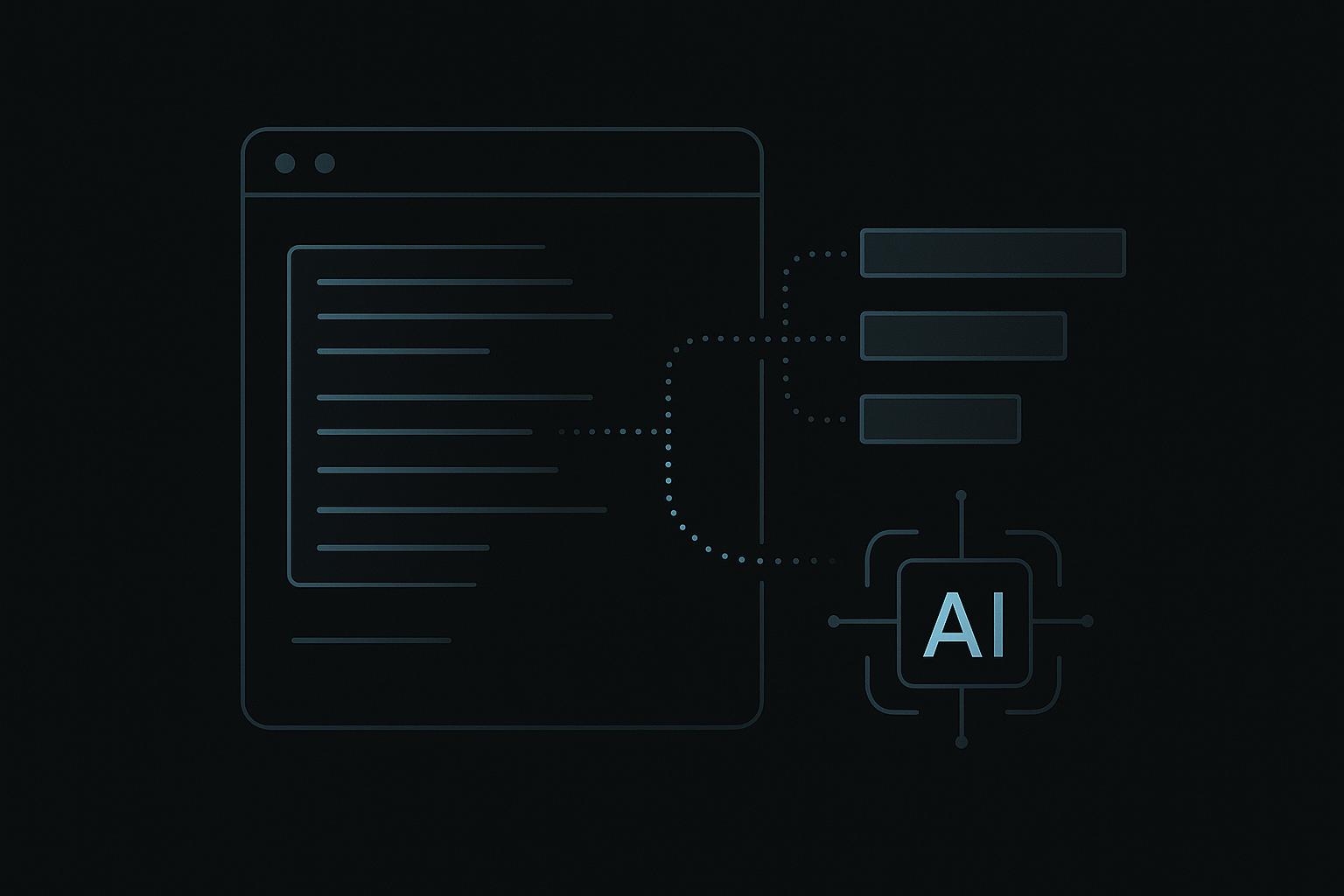AI tools are revolutionizing real estate by making data collection faster, more accurate, and insightful. Here's what you need to know:
- AI-Powered Tools: Automate property valuations, forecast markets with 20% more accuracy, and provide tailored recommendations.
- Web Scraping: AI-driven scraping tools extract data like property listings, pricing trends, and demographics with 99.5% accuracy, saving 30–40% of time compared to manual methods.
- Challenges: Issues like scattered data, inconsistent formats, and manual processes are being solved with AI.
- Advanced Techniques: NLP analyzes text for details like renovations, while computer vision extracts features from photos. Geospatial analysis evaluates locations using satellite and drone data.
- Legal and Ethical Compliance: Adhering to GDPR, CCPA, and copyright laws is critical to avoid fines.
Quick Summary Table
| Feature | Benefit | Impact |
|---|---|---|
| Automated Updates | Real-time property insights | 40% better pricing strategies |
| Pattern Recognition | Detect market trends faster | 20% improved forecasting |
| Adaptive Algorithms | Adjust to website changes | High data accuracy maintained |
| Image Analysis | Extract property details | Enhanced property evaluation |
AI is streamlining real estate processes, making them faster and more efficient while reducing costs and errors. Tools like InstantAPI.ai offer accessible solutions for professionals to stay competitive.
Automate Real Estate Data Analysis with AI & n8n|Full ...
AI Web Scraping in Real Estate
The real estate industry is undergoing a major shift thanks to AI-driven web scraping tools. These technologies are changing the way property data is collected and analyzed, making processes faster and more accurate.
Main Uses of AI Data Collection
AI web scraping is now a go-to method for gathering real estate data efficiently. This technology can automatically pull and process information from various sources, including:
- Property listings and pricing trends
- Market analytics and future projections
- Neighborhood demographics
- Property history and features
- Potential investment opportunities
Recent industry stats show that companies using AI scraping tools save 30–40% of the time compared to older methods. These tools shine in large-scale projects, processing thousands of listings with a 99.5% accuracy rate in analyzing detailed content. This boosts market responsiveness and improves forecasting precision.
How AI Enhances Data Collection
AI-powered scraping brings advanced features that elevate real estate data collection:
| Feature | Benefit | Real-World Impact |
|---|---|---|
| Automated Updates | Cuts down on manual monitoring | 40% better pricing strategy efficiency |
| Pattern Recognition | Spots market trends more quickly | 20% improvement in forecasting accuracy |
| Adaptive Algorithms | Adjusts to website changes seamlessly | Reduces manual fixes, ensuring high data quality |
| Scale Processing | Handles multiple data sources at once | 40% lower operational costs |
Rules and Guidelines
Using these advanced methods comes with responsibilities. Legal and ethical guidelines are crucial for maintaining data integrity while using AI web scraping in real estate.
Legal Requirements:
- Follow website terms of service.
- Comply with regulations like GDPR and CCPA.
- Obtain authorization when accessing protected data.
Ethical Practices:
- Protect data privacy and security.
- Use data fairly and responsibly.
- Be transparent about data collection methods.
"Organizations leveraging AI data scraping in the US must adhere to existing federal and state laws safeguarding sensitive personal information. Parties not adhering to these policies may be subject to legal action." - Quintairos, Prieto, Wood & Boyer P.A.
Failing to comply with copyright laws can result in fines as high as $150,000 per violation. GDPR breaches could lead to penalties of up to €20 million or 4% of global revenue. To avoid these risks, regular audits and compliance checks are essential for using AI scraping tools responsibly while maximizing their potential.
Modern Real Estate Data Methods
The real estate industry now leverages AI-powered tools and analytics to provide detailed insights into property features and market trends. These advanced methods build on previous uses of AI in data collection, offering more precise and in-depth property information.
Text Analysis with NLP
Natural Language Processing (NLP) adds a new layer to property data analysis. By using techniques like tokenization, lemmatization, and n-gram analysis, it identifies details often overlooked by traditional methods - such as mentions of "recently renovated" spaces or "hardwood floors."
Extracting Data from Images
AI-driven computer vision can analyze property features directly from photos. With the computer vision market valued at $20.31 billion in 2023 and expected to grow to $175.72 billion by 2032[1], this technology automatically identifies rooms, architectural elements, and other details. Combining LiDAR with photogrammetry further enables accurate 3D models to be created from 2D images, offering a detailed view of spatial layouts.
Location Data Analysis
Geospatial analysis helps uncover critical information about property locations and surrounding neighborhoods. By incorporating satellite imagery and drone data, analysts can assess proximity to amenities, demographic patterns, potential risks, and future development opportunities - essential factors for making informed investment decisions.
These advanced techniques improve how property data is gathered and analyzed, paving the way for better integration and market forecasting.
sbb-itb-f2fbbd7
Working with Property Data
Once real estate data is collected, organizing and analyzing it effectively is key to gaining useful insights. AI-powered tools have reshaped how property information is managed, offering improved accuracy and better support for decision-making.
Cleaning Property Data
Raw property data often contains inconsistencies that can distort analysis. To ensure reliable results, a thorough cleaning process is necessary. Start by eliminating duplicate listings and standardizing key data points like addresses, prices, and square footage.
Here are some essential cleanup steps:
- Convert all measurements to consistent units (e.g., square feet for area, USD for prices).
- Use a uniform date format, such as MM/DD/YYYY, for U.S. data.
- Remove special characters and excess spaces from text fields.
- Standardize phone numbers and email addresses.
Clean and standardized data lays the foundation for accurate analysis. Once this is done, the next step is merging datasets from various sources.
Merging Data from Multiple Sources
Bringing together property data from different sources requires precision to maintain accuracy. AI tools can simplify this process by matching and merging datasets effectively. The process typically involves:
| Step | Purpose | Key Focus |
|---|---|---|
| Source Validation | Ensure data reliability | Check data freshness and provider reputation |
| Field Mapping | Align data fields across sources | Use consistent naming conventions |
| Deduplication | Eliminate duplicate entries | Leverage AI to identify redundancies |
| Quality Verification | Confirm accuracy of merged data | Cross-check with reliable sources |
With clean and integrated data, AI systems can then deliver detailed market insights.
Leveraging AI for Market Forecasting
AI has transformed real estate market predictions by analyzing factors like historical sales, pricing trends, local economies, demographics, and property details. These tools help spot new trends and investment opportunities before they become widely apparent.
"Better and cleaner data outperforms the best algorithms. If you use a very simple algorithm on the cleanest data, you will get very impressive results. And, what is more, it is not that difficult to perform basic preprocessing!" - Max Ved
What's Next in Property Data
Blockchain and IoT Effects
Blockchain and IoT are reshaping how property data is managed. For example, Sweden's Lantmäteriet land registry uses a blockchain-based system to cut transaction times from months to just days. It eliminates the need for paperwork and updates ownership records instantly.
IoT devices are also playing a growing role in collecting property data. With consumer spending on IoT-based smart home systems expected to hit $157 billion by 2025, these systems are delivering real, measurable outcomes:
| Capability | Impact | Cost Savings |
|---|---|---|
| Energy Management | Automated HVAC control based on occupancy | Up to 30% reduction |
| Maintenance Alerts | Real-time leak detection and notifications | Preventive repairs |
| Space Utilization | Counting people to optimize space usage | Improved efficiency |
These advancements are also pushing the boundaries of data privacy rules.
New Data Privacy Rules
As technology evolves, data privacy laws are keeping pace. Regulations like the California Delete Act and Canada's Bill C-27 are focusing on transparency, giving users more control over their data and ensuring stricter security measures.
Future of Property Data
The future of property data looks even more streamlined. Dubai's REST platform showcases how blockchain can enable instant property transactions without intermediaries. Meanwhile, Baltimore's blockchain pilot project efficiently manages ownership records for over 13,600 vacant properties.
The IoT market is also booming, with annual growth projected at 26%, reaching nearly $2.5 trillion by 2029. Plus, 52% of commercial real estate firms now view IoT sensors and artificial intelligence as critical for meeting tenant demands.
"Combining AI and blockchain can greatly improve efficiency, transparency, and security in real estate transactions." – Legaliser CMS
Main Points Summary
AI-powered tools have revolutionized how real estate data is extracted. Modern web scraping now delivers exceptional accuracy, with success rates surpassing 99.99% across multiple real estate platforms.
Here are some core features that drive business impact:
| Feature | Benefit | Outcome |
|---|---|---|
| Automated Data | Real-time insights | Faster decision-making |
| Data Formatting | Organized information | Simplified integration |
| Anti-Bot Bypass | Uninterrupted access | Reliable data tracking |
| JavaScript Rendering | Access to dynamic content | Comprehensive data coverage |
These features make it easier than ever to integrate data extraction into your workflow.
Next Steps with InstantAPI.ai
Get started with property data extraction for as little as $0.005 per page. Use our Web Scraping API for seamless integration or opt for the Chrome extension to extract data effortlessly - no coding required.
"After trying other options, we were won over by the simplicity of InstantAPI.ai's Web Scraping API. It's fast, easy, and allows us to focus on what matters most - our core features." - Juan from Scalista GmbH
Whether you need property listings, market trends, or pricing data, our platform tailors outputs to your requirements. The built-in AI ensures your data is formatted exactly how you need it, removing the hassle of manual updates.
Upgrade your real estate data process with automation and smooth integration. As the property market changes, these tools help you stay competitive with accurate, actionable insights.


